The Three Bears
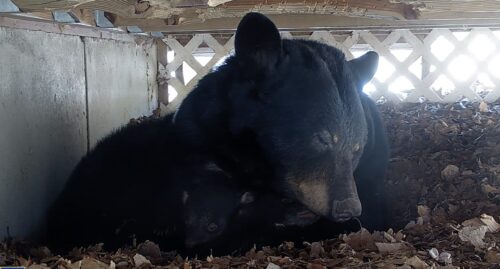
Fast asleep with her cubs tucked in
On April 6th, they left around 8:00 in the evening. The two cubs’ heads were snuggled up against their mother’s belly as if they had fallen asleep while nursing. The bigger cub stirred, began to squirm, and then clambered over its sibling and on top of its mother. The cubs did this all the time—using their mother’s big body like a log—but this time she heaved up, sending both cubs rolling, and walked straight out of the den. The bigger cub righted itself and trotted after her. The smaller one wobbled for a minute or two. Go, I urged, catch up.
The three of them had left the den before, but this was different. The mom moved with purpose, as if she had somewhere else to be. This turned out to be true; she was leaving the den for good. I felt let down and sad that I wouldn’t be able to keep watching the bears, but also immensely grateful. For a few weeks, I’d had an opportunity to peer into a bear den–an unknown world.
Back in November, a mother bear made her den beneath a deck in the Poconos in northeastern Pennsylvania. With lots of varied food sources, Pennsylvania is excellent bear country. An estimated 15,000 to 16,000 bears live in the state, mostly along the wooded Appalachian chain and especially in the northeast.
The homeowners had planned to replace their side porch, but when the carpenters arrived, they found the bear fast asleep in one corner. They let her be. The state Game Commission set up a wildlife camera and microphone, and a lot of people started to watch. I learned about it in March and as soon as I spotted a cub, I was hooked. I showed my wife, and she was hooked. We shared the link with family and friends, who shared it with their family and friends, and many of them got hooked, too. With infrared lighting, the bears were visible night and day. I checked in a lot.
The mother bear was groggy, sluggish. When the cubs nosed into her side, she arranged herself to let them nurse and fell back to sleep. At times, she propped herself up against the wall, but her head soon lolled to one side. She expanded her hole, settled in, and fell back to sleep. When the bigger cub climbed on her head and chewed her ear, which happened more and more, she shook it off and sometimes set a big paw on it, and fell back to sleep. Noises, however, woke her right up. She’d go on alert and then slowly lower her head. For a time, she kept her eyes open, but then fell back to sleep.
The cubs were easy to tell apart. One was larger, a darker color, active, and bold. This cub pounced on its sibling; climbed up its mother’s side, tumbled off, and climbed again; and balanced atop her back and clawed at the rafters (the joists, really). When one of its claws snagged in the wood, it would teeter, dangle, and then fall. We dubbed this one Ramona, in honor of Ramona the Pest, the lead character in the children’s book of that name. The other was smaller, about two thirds the size, and a lighter color. It was not as strong and much shakier on its feet. This one tended to stay tucked up against its mother. When Ramona pounced, it would try to hold its ground. It didn’t wrestle much. We dubbed this one Mr. Beasley—just because. Later, from a post on the comments thread, we learned that we had by chance gotten the sexes right.
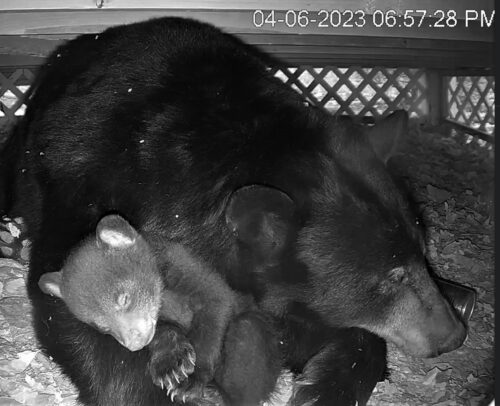
Mr. Beasley snuggled up, right where he liked to be.
Ramona steadily grew more active and adventurous. She spent more time perched atop her mother’s back stretching for the rafters. She roughed up her brother. She poked into the corners and started to venture outside.
Mr. Beasley, though slowly and tentatively, played and explored, too. Occasionally, he even jumped Ramona and initiated their play. I realized that Ramona’s pesty qualities weren’t pesty at all. She was not only learning and getting stronger as she rolled her little brother, but she was helping him learn and get stronger, too.
The bears must have heard the camera. It’s not surprising, since bears’ hearing is twice as sensitive as ours and picks up a wider frequency of sounds. The mother bear often looked right at the camera, more than by chance. Ramona nosed and pawed it. Several times, when I opened the link, the camera was pointing up at the boards or down at the ground, until someone readjusted it from afar. The bolder Ramona became, the more frequently this happened.
As the cubs grew more active, so did their mother. She seemed less inclined to fall fast asleep whenever she could, though she still slept plenty. She started to leave the den and forage in the local trash cans. Cans, jars, wrapping, and plastic bags littered the space. Trash wasn’t exactly part of my image of a bear’s den. I realized it was time to go learn more about bears.
The first thing I had to rethink was the den. Den connotes shelter, a cozy retreat, a nice dry cave. Far from it. In late fall, though exactly when depends on climate and food supply, bears find a den. Black bears den in all sorts of places—in cavities under the roots of fallen trees, hollowed out logs, holes dug into banks, indentations in the ground, and, yes, even caves. They’ll excavate if necessary and line the space with leaves, bark, and twigs. This mother bear dug a bear-size hole against a foundation wall and chewed into the joists directly above her hole to expand her space. (Good thing the homeowners had already planned to rebuild the deck.) The cold poses less of a problem than I’d assumed, because when bears curl up, only their thickly furred backs are exposed. But what about the cubs? Their mother’s body is their den within the den, offering warmth, shelter, and protection. Some commenters on the web-cam site worried about the cold and the snow and rain getting in on the bears. But really this mother had found luxury digs, spacious and well drained–even though her denning under a deck is a sign of habitat loss.
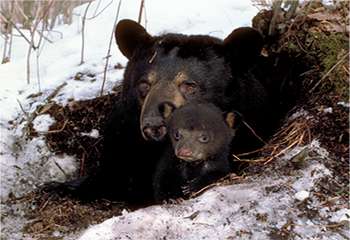
A more typical den. Photo: North American Bear Center
Next was hibernation. The mother bear’s behavior didn’t look like hibernation as I have always thought about it: A deep suspension that carried a creature through the whole winter. That clearly wasn’t the case here. Was she really hibernating? What state was the mother bear in when she gave birth? Could she really be alert enough to care for her newborns? If she was awake, did she need food or water? Did she pee and poop in the den?
Here’s what I found. For mammals, hibernation is broadly defined as a seasonal reduction in metabolism that enables a species to survive the cold and lack of food, with an emphasis on broadly. It covers a range of adaptations from the continuous hibernation of a woodchuck, whose metabolic rate and body temperature plummet and stay low; to the phased hibernation of a chipmunk, which wakes every few days to raise its body temperature, eat from its store of food, move around, and pee, before going back to sleep.
The bear falls in the middle of this range. A bear’s metabolic rate drops but not extremely. Instead of taking six to ten breaths per minute, it takes one every 45 seconds; its heart rate dips from 40 to 50 beats per minute to eight to 19 beats. No wonder the mother bear kept nodding off! A bear’s body temperature also drops, but only about 12 degrees and never falls below 88. Her core stays warm, which enables her to warm her cubs. She also retains enough brain function to care for them. The temperature change can actually vary den by den. If a mother bear’s den is in the open, her body temperature stays close to normal.
For bears, the problem is lack of food. A New England black bear doesn’t eat—though it may occasionally wake, leave the den, and drink—between November and late March or early April, but lives off its stored fat. A Minnesota black bear, where winters last longer, dens from September or October until April. It depends, too, on variable food supply; in years when fewer tree nuts are available, bears hibernate earlier. They can lose 15-30% of their body weight, and nursing mothers as much as 40%. As Mary Holland reports in her book Naturally Curious, a nursing mother loses from about a third to over half a pound a day.
To make it through, bears need a lot of fat. In the late summer and early autumn, they enter the first phase of hibernation, a period of insatiable hunger called hyperphagia, and build fat. This layer of fat can become several inches thick. While chipmunks store as much food as they can in their burrows, bears store as much food as they can in their bodies. During hyperphagia, they may consume over 20,000 calories a day. That means eating whatever they can find wherever they can find it, and eating pretty much all the time. Check out the “Fat Bear Week” contest in early October, sponsored by Katmai National Park in Alaska, when they track how impressively large some of the grizzlies grow by catching salmon along the Brooks River. In 2022, a bear numbered 747–I thought he was named for the jumbo jet–won the adult bracket.
Bears have another extraordinary adaptation: delayed implantation. While they mate in May and early June, the fertilized egg only implants in the uterine wall around the time the bear dens. Whether a bear’s pregnancy will take or not depends on her weight. The typical litter is two to three cubs. The North American Bear Center in northern Minnesota reports that, in that region, mother bears weighing 176 pounds or more give birth in January and have enough milk to support their cubs. Female bears weighing less than 148 pounds don’t give birth at all. Those weighing between 148 and 176 pounds may or may not give birth, and the cubs may or may not make it.
We wondered if the mother bear peed or pooped in her den. No. When a bear hibernates, her system forms an intestinal plug made up of feces, hair, and dead cells. She processes her wastes by reusing them. The urea, which is produced as she burns her fat and becomes dangerous as it builds up in the blood, gets broken down. One of the products of that process, nitrogen, builds protein that supports her muscles and organs. Remarkably, bears leave their dens in the spring with about as much muscle as they had in the fall. The first poop of the spring is the fecal plug. Since food isn’t plentiful in the early spring, she still lives off her stored fat to sustain herself and her babies. In the early weeks of moving around, her gut and metabolism gradually return to normal.
We missed Ramona and Mr. Beasley’s earliest days. Of course, there wasn’t a whole lot to miss, since they did little but sleep, nurse, and grow. The mother bear slept when they slept, and roused in her groggy way when they needed her. At birth, they were tiny and helpless. They weighed eight to 12 ounces, were seven to eight inches long, couldn’t see or hear, and had little fur. Their mother, despite her lowered metabolism, cleaned them, nursed them, warmed them, protected them, and licked their genital area and anus so they would pee and poop--and consumed their stools to get any nutritional benefit. So she does eat, though it can’t count for much.
The cubs grew a lot. During a mother bear’s early lactation, her milk’s fat content can be as high as 30%. That’s as rich as whipping cream. By the time a cub leaves the den, depending on its mother’s milk production and the size of the litter, it is between four and 10 pounds. Cubs stay with their mother through the year and hibernate with her their first full winter. By the time the family hibernates the following fall, a cub weighs close to 80 pounds. They are usually weaned in the fall, but sometimes not until the spring. Then, their mother runs them off, and she mates again.
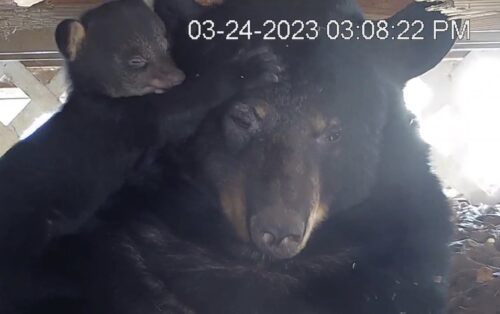
I loved watching the mother bear. Even half asleep, she moved her big body carefully so she wouldn’t crush her babies. There was something familiar, tender, and comic in her attempts to sleep while Ramona, and increasingly even Mr. Beasley, clambered up her side and perched atop her head.
The cubs were irresistible. Humans invented teddy bears for good reason, since bear cubs might as well be puppies, kittens, and human babies wrapped into one. Underneath our sentimental goofiness about cubs, there’s a biological imperative called the cute response. Many mammals, including human ones, have evolved attention and caretaking responses to certain features of baby animals, which are called the baby schema. Simply put, sections of the brain reflexively kick into gear at the sight of these features. As an adaptation this makes good sense, since the animals most attuned to their young's needs are more likely to pass on their genes.
I wrote about the cute response earlier in the article “Your Brain on Babies,” so I’ll borrow from myself for the rest of this paragraph to describe the baby schema: First, there’s babyfacedness: a proportionally large round head and prominent forehead; big eyes, facing forward and positioned slightly lower on the face; and a small nose, small mouth, receding chin, and round cheeks. Next, there’s the soft round body, with short pudgy legs and arms and soft flexible skin. In other words, your classic cute baby. The “cutest” babies, the ones who fit these patterns most closely, have the most intense effects on our brains, whether we’re conscious of it or not. Finally, the cute response comprises more than looks, but the whole baby package. We respond to the clumsy movements, wobbling, playfulness, and helplessness of infants, toddlers, and small children.
But why do I have the cute response to a bear cub? Apparently, the brain doesn’t distinguish between baby bears and baby humans. Mr. Beasley, wobbly and uncertain, paused before toddling after his mother and sister into an unknown future, and the whole baby package elicited my attention and urge to take care of him. And here’s Ramona looking especially endearing, with Mr. Beasley a bit out of focus in front.
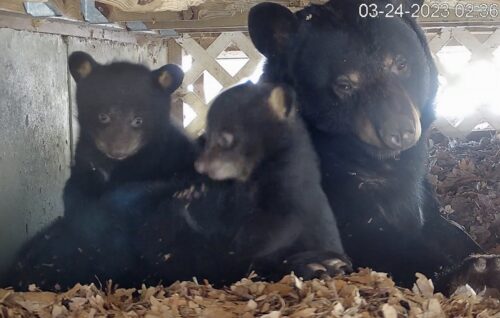 The bear watchers were all under the spell of the cute response. Whenever I opened my computer and started to follow Ramona and Mr. Beasley, I entered a time warp, the way it feels to hang out with human babies. An hour could slip by before I knew it.
The bear watchers were all under the spell of the cute response. Whenever I opened my computer and started to follow Ramona and Mr. Beasley, I entered a time warp, the way it feels to hang out with human babies. An hour could slip by before I knew it.
I became curious about my fellow bear watchers, as well. At first, I ignored the comment thread, but then started to read and appreciate it. I’d watch the bear cam and, when the mom and cubs settled, scroll down. Comment threads often degenerate, but this one was warm and generous. Once or twice, a curmudgeon tried to burst the sweet bubble, but without success. I suspect the cute response helped shape the community around a positive interest and cause: the welfare of the bears. No snark allowed! People admired the mother bear, identified with her sleepy patience, and out and out loved the “little bear family.” They anthropomorphized like crazy, but I’m pretty sure they knew they were doing it. They also posed questions about the mother’s and cubs’ behavior and bears in general, and thanked one another for information. After Ramona knocked the camera off kilter, they thanked the technician who readjusted it. If the den was empty and someone worried “Oh, no–have they left for good?” someone else would respond that they’d seen them shortly before and send a screenshot. Finally, lots of people expressed their gratitude to the homeowners for making the bears welcome and the experience possible.
After the little cub trundled after his sister and mother and the three bears left the den for good, the bear watchers grieved. Some admitted crying, one wrote poems, and many suffered bear-cam withdrawal. I only know this because I kept checking the website: Maybe the bears hadn’t really left yet (I knew better). I also wondered about my fellow humans. What were they saying now? Some posted screenshots and video clips as gifts for the rest of us. I’ve used some of those screenshots here.
The last time I checked, on May 4th, a few bear watchers were still posting comments to the site. The camera was down, the Game Commission had posted an informative wrap-up video, and the homeowner reported that the bear family was still in the area and that both cubs were “healthy and thriving.” Sadly, that post also included news that a different mother bear in the area had been shot and killed. Her cubs had stayed near her body before being rescued by game wardens. The hopeful news: these cubs were probably left with other mother bears with newborn cubs, who usually accept orphans and raise them as their own. Most foster bears make it.
One creative, technically savvy person posted an idyllic forest scene with the bear family photoshopped into it.
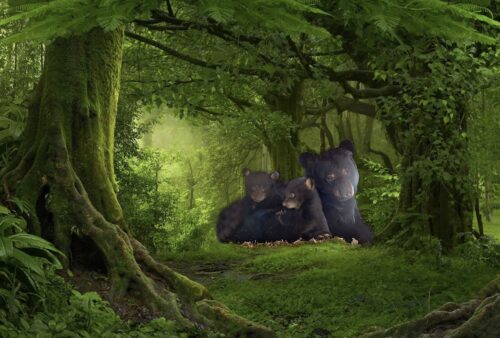
This is a crazily unrealistic view of nature, of course, even leaving humans out of it. But I still love it. If only this lovely green world were real, and the three bears safe. Especially Mr. Beasley. Though the homeowner said the little bear’s gaining weight and catching up with his sister, I worry about him.
Want to know more about bears?
My research led me to terrific sources.
Mary Holland. Naturally Curious: A Photographic Field Guide and Month-by-Month Journey through the Fields, Woods, and Marshes of New England (Trafalgar Square Books, 2010, revised 2019).
I already owned this book and had consulted it about peepers and newts, owls, wildflowers and trees. It’s an engaging guide to what is happening in the woods where I walk in different seasons. Holland has a lot of material on bears.
The author has a great blog, also called Naturally Curious https://naturallycuriouswithmaryholland.wordpress.com/category/naturally-curious-blog/
She posts photographs with short focused articles that are relevant to the season.
Check out the website for the North American Bear Center, based in Ely, in the northeastern part of Minnesota: https://bear.org/bear-facts/black-bears/basic-bear-facts/
Not only is there a lot of information on this site, but also many photographs and videos. This includes a video of a mother bear in her den with her cubs.
The Kilham Bear Center in western New Hampshire takes in orphaned bear cubs from New Hampshire, Vermont, and Massachusetts. For thirty years, they have raised and prepared cubs for reintroduction to the wild as yearlings, in collaboration with the New Hampshire Fish and Game Department and U.S. Fish and Wildlife Service. Many of the bears have thrived and had many of their own cubs. Here’s their link: https://kilhambearcenter.org/
The Pennsylvania Game Commission posted a short video about the bears–hibernation, denning, and cubs–featuring one of their bear biologists, Mark Ternent:
The Game Commission also produced Pennsylvania Black Bear Den 2023 Wrap Up, a 30-plus-minute video with Emily Carrollo, a black bear biologist, and Bryan Mowrer, a game warden, both from the agency. It’s fun and really informative.
Just in case the mother bear returned, no one entered the den for over a week after the bears left. The film opens as Carrollo and Mowrer crawl into the den and ends as they crawl back out, hauling cans, jars, and wrappers with them. They use the film as an opportunity to respond to people’s questions directly, to educate the public about bears in general, and to minimize dangerous interactions between bears and people.
They recommend a website about safely sharing our habitat with bears: https://bearwise.org/
This site also offers a lot of excellent information about bear biology.
The National Park Service provides information that is largely geared to park visitors in order to keep both people and bears safe. Here’s their main information page: https://www.nps.gov/subjects/bears/index.htm
Individual parks where bears are common, such as Yellowstone National Park, have information specific to their own bears and region. https://www.nps.gov/yell/learn/nature/grizzlybear.htm
I found this thoroughly researched article on grizzlies in Yellowstone on the park website:
Mark J. Biel and Kerry A. Gunter, “Denning and Hibernation Behavior.” INFORMATION PAPER No. BMO-10. Bear Management Office, Yellowstone National Park.
https://www.nps.gov/yell/learn/nature/denning.htm
And, finally, there’s “Fat Bear Week”–a playful way to educate us humans about bears. Katmai National Park and Preserve, located at the base of the long peninsula that separates the Gulf of Alaska from the Bering Sea and home to an abundant salmon run in the Brooks River, sponsors “an annual celebration of success” in early October. https://www.nps.gov/katm/learn/fat-bear-week.htm.
